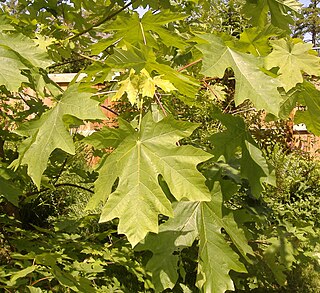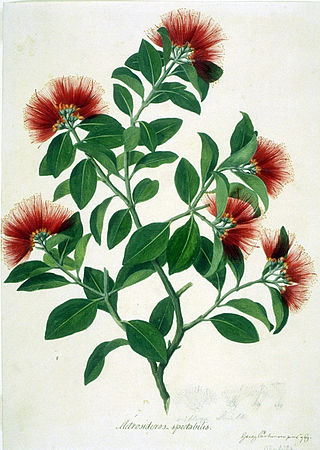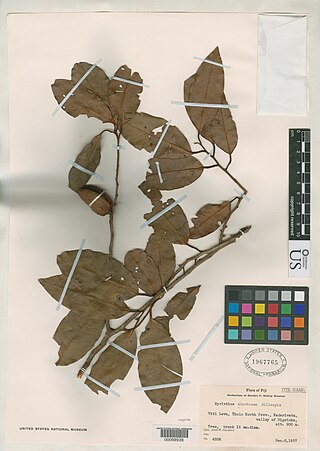
The Vanuatu rain forests are tropical and subtropical moist broadleaf forests ecoregion which includes the islands of Vanuatu, as well as the Santa Cruz Islands group of the neighboring Solomon Islands. It is part of the Australasian realm, which includes neighboring New Caledonia and the Solomon Islands, as well as Australia, New Guinea, and New Zealand.

The Solomon Islands rain forests are a terrestrial ecoregion covering the Solomon Islands archipelago.

Laurel forest, also called laurisilva or laurissilva, is a type of subtropical forest found in areas with high humidity and relatively stable, mild temperatures. The forest is characterized by broadleaf tree species with evergreen, glossy and elongated leaves, known as "laurophyll" or "lauroid". Plants from the laurel family (Lauraceae) may or may not be present, depending on the location.

Acer macrophyllum, the bigleaf maple or Oregon maple, is a large deciduous tree in the genus Acer. It is native to western North America. In addition to uses by animals, it is of some culinary and woodworking interest.

Agathis macrophylla known as Pacific kauri, is a coniferous tree native to the islands of the southwestern Pacific Ocean in tropical humid lowlands and lower montane regions, notably in Fiji, Vanuatu, and the Santa Cruz Islands. The Pacific kauri is one of the largest and fastest growing species in its genus, and is important in forestry.
Leptolaena cuspidata is a species of flowering plant in the Sarcolaenaceae family. It is found only in Madagascar. Its natural habitats are subtropical or tropical dry forests and subtropical or tropical moist lowland forests. It is threatened by habitat loss.
Calophyllum chapelieri is a species of flowering plant in the Calophyllaceae family. It is found only in Madagascar, where it lives in the island's eastern lowland rainforests.

Platymantis vitiensis is a species of frog in the family Ceratobatrachidae. It is one of two endemic frogs in Fiji, the other being the closely related Platymantis vitianus.

Metrosideros collina is a species of flowering plant in the family Myrtaceae. It is a tree or shrub native to French Polynesia, the Cook Islands, and the Pitcairn Islands.

The Samoan tropical moist forests are a tropical moist broadleaf forest ecoregion in the Samoan Islands of the Pacific Ocean.
Endospermum medullosum, commonly known as the whitewood, is a dioecious plant that grows in the tropical islands. It grows in tropical humid climates. The species is well known for timber.
Palaquium hornei is a tree in the family Sapotaceae.

The Fiji tropical moist forests is a tropical moist forest ecoregion in Fiji and Wallis and Futuna. It covers the windward sides of Viti Levu and Vanua Levu, Fiji's largest islands, as well as the smaller Fijian islands and the three islands that make up Wallis and Futuna, an overseas territory of France. The drier leeward sides of Viti Levu and Vanua Levu are home to the distinct Fiji tropical dry forests ecoregion.

The Tongan tropical moist forests is a tropical and subtropical moist broadleaf forests ecoregion that includes the Tonga archipelago and Niue.
Sri Lanka exhibits a remarkable biological diversity and is considered to be the richest country in Asia in terms of species concentration.

Cassipourea malosana is a species of plant native to tropical Africa.
Metrosideros vitiensis is a species of flowering plant in the family Myrtaceae. It is a shrub or tree native to Vanuatu, Fiji, and the Samoan Islands.
Quercus oidocarpa is a species of oak. It is a tree native to parts of Indochina and western Malesia, including Myanmar, Thailand, Vietnam, Peninsular Malaysia, Borneo, Sumatra, and Bangka. It grows in lowland and montane tropical moist forests from 150 to 1,700 metres elevation.
Myristica inutilis is a species of flowering plant in the nutmeg family, Myristicaceae. It is a tree native to the South Pacific, ranging from New Guinea through the Bismarck Archipelago and Solomon Islands to Vanuatu, Wallis and Futuna, and the Samoan Islands. It is not native to Fiji, but may be present in Tonga.

Myristica chartacea is a species of flowering plant in the nutmeg family, Myristicaceae. It is a tree endemic to Fiji.













